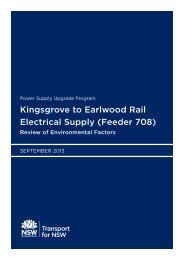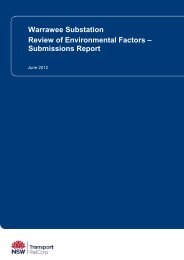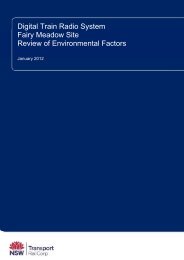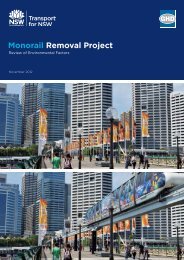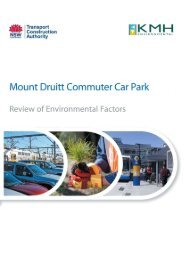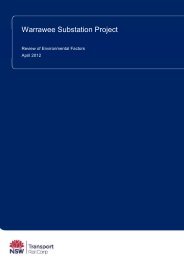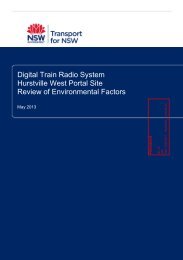Glenbrook Sation REF (pdf 3.15MB) - Transport for NSW - NSW ...
Glenbrook Sation REF (pdf 3.15MB) - Transport for NSW - NSW ...
Glenbrook Sation REF (pdf 3.15MB) - Transport for NSW - NSW ...
- No tags were found...
You also want an ePaper? Increase the reach of your titles
YUMPU automatically turns print PDFs into web optimized ePapers that Google loves.
Review of Environmental Factors<strong>Glenbrook</strong> commuter car park and interchange upgradeGuidelines that contain additional advice relating to potential sleep disturbance impacts have beenconsidered, including the Road Noise Policy (RNP). The RNP provides a review of research into sleepdisturbance. From the research to date, the RNP concludes that:• Maximum internal noise levels below 50 dBA to 55 dBA are unlikely to awaken peoplefrom sleep• One or two events per night, with maximum internal noise levels of 65 dBA to 70 dBA, arenot likely to affect health and wellbeing significantly.It is generally accepted that internal noise levels in a dwelling, with the windows open are 10 dB lowerthan external noise levels. Based on a worst case minimum attenuation, with windows open, of 10 dB,worst‐case short term internal noise levels are at a level that according to the RNP review is unlikely tocause awakening reactions.It is there<strong>for</strong>e concluded that the operation of the proposed commuter car park is unlikely to cause asignificant adverse noise impact at nearby noise sensitive receivers.Additional trafficIn terms of additional traffic on nearby streets, a negligible increase in traffic flow would be expected dueto the proposed commuter car park. It would also mostly be limited to peak commuter times. On thisbasis, the noise level contribution from activities within the upgraded commuter car park and anyadditional road traffic to and from the proposed commuter car park would be considered to be unlikelyto represent an adverse noise impact.6.4.6 Mitigation measures<strong>Transport</strong> <strong>for</strong> New South Wales has prepared a Construction Noise Strategy (<strong>Transport</strong> Projects) whichprovides practical guidance on how to minimise, to the fullest extent practicable, the impacts on thecommunity from noise and vibration generated during the construction of rail projects (and relatedinfrastructure) through the application of all feasible and reasonable mitigation measures.The strategy includes a standard suite of noise and vibration management measures that are to beapplied on all projects, together with additional mitigation measures which are applicable whenconstruction noise or vibration is predicted to exceed the project’s construction noise and vibrationobjectives.The standard suite of mitigation measures includes management measures such as communityconsultation, site inductions (with guidance on how to minimise noise and vibration) and the preparationof site specific Construction Noise and Vibration Management Plans. The strategy also includes severalrecommendations <strong>for</strong> reducing the source noise levels of construction equipment via good planning andequipment selection.In many instances, impacts from construction noise are unavoidable and it is not feasible to achieve theconstruction noise objectives. There<strong>for</strong>e the <strong>Transport</strong> <strong>for</strong> New South Wales Construction Noise Strategyincludes a list of additional noise mitigation measures which aim to minimise the potential noise impacts.These include measures ranging from letter box drops and phone calls to offers of alternativeaccommodation (should noise intensive night‐time works be required). A summary of the additionalnoise mitigation measures matrix is provided in Table 6‐20. The purpose of letter box drops is to providespecific notification of the duration and timing of the construction activities so that residents areRef No: 2260812 49



